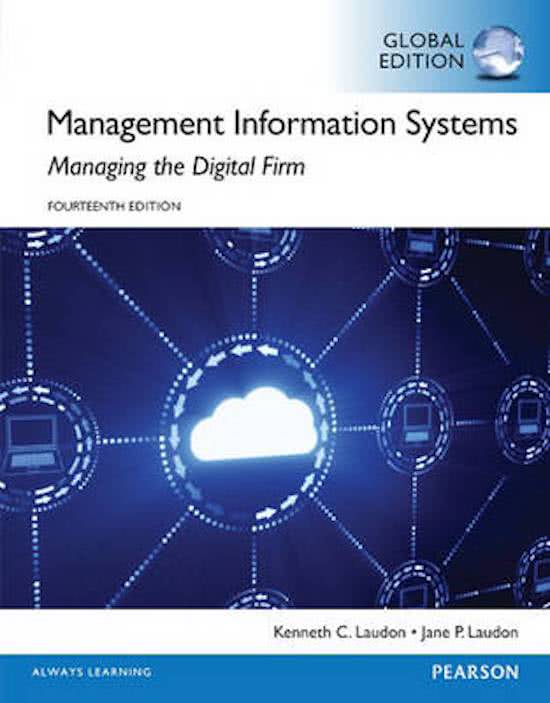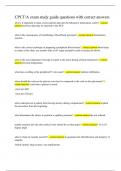Week 1: Information Systems of Today
Information system: a set of interrelated components that collect, process, store, and distribute
information to support decision making and control in an organization
Input, processing and output make sure information systems produce the information that
organizations need to make decisions, control operations, analyze problems and create new products
or services.
Input collects raw date from the organization or it’s environment, processing converts this raw input
into meaningful data, output transfers the processed information to the people who will use the
information. Feedback is also a part of information systems.
Information systems have three dimensions: organizations, technology and management.
Organizations: hierarchy consisting of senior management, middle management and operational
management. Information systems serve each of these levels. Every organization also has its own
culture: way of doing and things, beliefs etc.
Management: management needs to make decisions, make plans and solve problems the
organization faces. This is done with the help of knowledge and information.
Information technology: is used within an organization to cope with change > software, hardware,
network
How are information systems transforming business and why are they essential for running and
managing a business today?
Email, smartphones and tablet computers have become essential for businesses. Information
systems are the foundation of supply chains. The internet allows many businesses to buy, sell,
advertise and check customer feedback online. Organizations are trying to become more competitive
and efficient by digitally enabling their primary business processes and evolving into digital firms. The
internet has stimulated globalization by dramatically reducing the costs of producing, buying and
selling goods on a global scale. New information systems trends include the upcoming mobile digital
platform, big data and cloud computing.
Explain what is an Information System, and describe how it works.
From a technical perspective, an information system collects, stores, and analyses information from
an organization’s environment to support organizational functions and decision making,
communication coordination, control, analysis and visualization. Information systems transform raw
data into useful information through three basic activities: input, processing and output.
Identify and elaborate on the management, organization, and technology aspects of an
Information System.
, From a business perspective, an information systems provides a solution to a problem or challenge
facing a firm and it has of management, organization, and technology elements. The management
dimension of information systems involves issues such as leadership, strategy, and management
behavior. The technology dimension consists of computer hardware, software, data management
technology, and networking/telecommunications technology. The organization dimension of
information systems involves issues such as the organizations hierarchy, business processes, culture
and political interest groups.
To obtain meaningful value from information systems, organizations must support their technology
investments with appropriate investments in organizations and management.
Define the relationship between Information Systems and Business Processes.
A business process is a set of activities that defines how specific business tasks are performed, and it
represents how an organization coordinates work, information, and knowledge. There are business
processes specific to each of the major business functions, but many business processes are cross-
functional. Information systems automate parts of business processes, and they can help
organizations redesign and improve these processes.
Describe the technologies used for collaboration and social business, and assess their importance.
Collaboration is working with others to achieve shared and explicit goals. Social business is the use of
social networking platforms to engage employees, customers, and suppliers, and it can enhance
collaborative work. Collaboration and social business have become increasingly important in business
because of globalization, the decentralization of decision making, and growth in jobs where
interaction is the primary value-adding activity. Collaboration and social business enhance
innovation, productivity, quality and customer service. Tools for collaboration and social business
include e-mail and instant messaging, wikis, virtual meeting systems, virtual worlds, cloud-based file-
sharing services, corporate collaboration systems such as Microsoft SharePoint and enterprise social
networking tools such as LinkedIn.
Name and elaborate on the different types of information systems, serving each managerial level
in a company.
Transaction Processing Systems (TPS): tracks the flow of the daily routine transactions necessary to
conduct business (payment, order processing).
Management Information Systems (MIS): produce reports serving middle management by
condensing information from TPS
Decision Support System (DSS): manages decisions that are unique and rapidly changes it
Executive Support System (ESS): provides data in the form of graphs, charts and dashboards
delivered via portals using many sources of information
Customer Relationship Management (CRM): coordinate the business processes surrounding the
firm’s customers
Week 2: Information Systems Linking the Enterprise, Organizations,
and Strategy
Name and describe the main 4 types of enterprise application systems.
Enterprise systems/enterprise resource planning (ERP): a system that integrates business processes
in manufacturing and production, finance and accounting, sales and marketing, and human resources
into a single software system.
1. Supply Chain Management Systems (SCM): help suppliers, purchasing firms, distributors,
and logistics companies share information about orders, production, inventory levels, and
delivery of products and services so they can source, produce and deliver goods and services
efficiently. This is an interorganizational system. (help manage relationships with suppliers)












